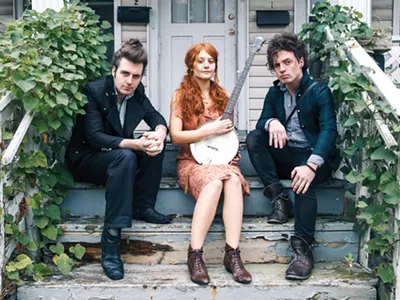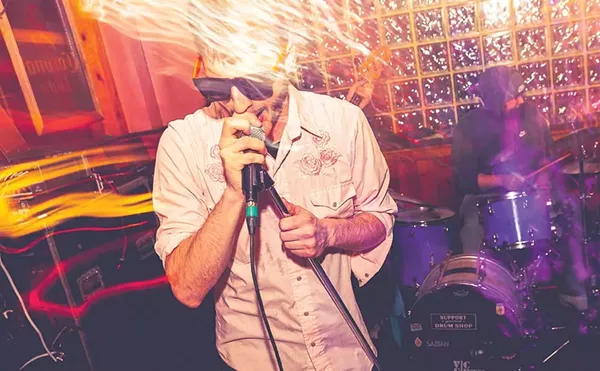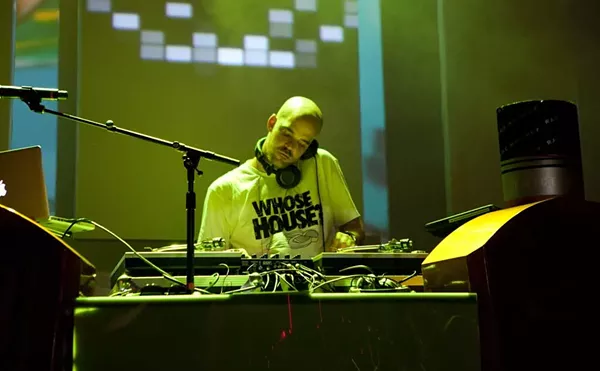When the lineup was announced for the 25th Concert of Colors — Detroit's free annual diversity-themed music festival — Griot Galaxy immediately jumped out. No Detroit jazz ensemble is more legendary for "what could have been" than the one that came to call itself the Sci-Fi Band. The late saxophonist, composer, and poet Faruq Z. Bey was the leader and sole constant member of the group, which became known musically for its distinctive use of odd meters with a strong rhythmic sensibility and visually for its theatrical appearance, featuring poetry-spouting members with faces painted silver.
A true visionary, Bey played with many musicians in all sorts of configurations throughout his life, but he will always be remembered for Griot Galaxy, which combined interests in poetry, philosophy, spirituality (particularly that of Islam), language, and totally free improvisation, all within the political context of black Detroit in the '70s. When the earliest groups that explored these aspects — including his work with the Bey Brothers and the First African Primal Rhythm Orchestra — faded away, Bey decided to reign it all in under a new name, Griot Galaxy, this time with more of a focus on composition and some sort of structure.
Formed in 1972, the group took many shapes (including a large nine-plus ensemble) before settling into the most stable line-up that helped take Bey's desire to experiment with structure to the next level: Anthony Holland and David McMurray joined him on saxophones (the latter also played flute), along with the supremely locked-in rhythm section composed of Jaribu Shahid on bass and Tani Tabbal on drums.
Other members of note at various points included poet Sadiq Bey and guitarist A. Spencer Barefield, who Holland worked with closely in the Roscoe Mitchell-founded Creative Arts Collective (Detroit's answer to the AACM, or Association for the Advancement of Creative Musicians), as well as Patrice Williams (known then as Kafi Patrice Nassoma) on flute and harp, and Elreta Dodds on clarinet and saxophone — among others. A full list would be much, much longer.
They certainly weren't the first to explore this musical territory, but Bey's complex lines and refined harmonies — in combination with Shahid and Tabbal's tightness from playing together in many different styles, and previous experience in odd meters and polyrhythms developed through working with one-time Sun Ra Arkestra trumpeter Phil Cohran — allowed the group to creatively flourish.
"When I came to Detroit [in the mid-'70s], Jaribu and Faruq had the same ideas, but in a different way, so when we got together it was like, let's build on this and make something really great," says Tabbal, who was born and raised in Chicago.
For McMurray, learning how to play those odd meters was one of the main things he took from the band — "how to think about it, pull everything apart and let it go, then catch that spot because that was the key," he says. The music was like a puzzle, but listening to it back, McMurray would be able to see how it all fit. "That was part of Faruq's writing," he says. "He could hear that."
"A lot of musicians don't have the opportunity to play in odd meters where the rhythm is constant and into a groove," Holland says. Further describing the intricacy of Bey's compositions, Holland says, "It allowed Faruq to realize, at least from a saxophonist's input, the ideas he was writing down on paper, to have them come to fruition in the actual performance of the music."
The group released its first album, Kins, in 1982. A masterwork of the creative Detroit jazz underground, the freeness of the playing on Kins was held down by a serious penchant for rhythm, evident in the way its members subtly layered their collective backgrounds in bebop, funk, reggae, and other styles within the tireless possibility of expression.
With a willingness to push boundaries that could almost be described as affectionate, Kins is Detroit's post-Coltrane, high-on-Sun-Ra bridge into the '80s with its own sad story to boot: Roughly three-quarters of the 2,000 that were pressed mistakenly ended up in the trash.
Another terrific release of furious creativity, Opus Krampus, was recorded live in Austria in July 1984 — and eventually came out the next year — but that fall, something terrible happened: Mystical freewheeling Faruq got into a motorcycle accident.
He fell into a coma and stayed there for a couple weeks. A closed head injury required serious rehabilitation. He returned to music, but through a combination of circumstances tragic and personal, the band as it existed before the accident did not, and could not, survive.
Some attempts to keep the band going were made, but the reality of what had happened presented challenges. The group had built themselves up to a certain standard; meanwhile, Bey more or less had to relearn everything. The effort to sustain some form of the band was too much, and they had disbanded in every sense by the beginning of the '90s.
In the time since, the two albums — which have never been re-released — have gained small but rabid cult followings among Detroit underground music nerds and lovers of obscure free jazz alike. (A third release, Live at the D.I.A. 1983, came out in 2003, showcasing the group at their heyday.)
Bey wrote most of the compositions that were recorded; Shahid wrote two and Tabbal one. Shahid, who saved all the sheet music, says "Androgyny" (on Kins) was an experiment in mixed meters dedicated to Sun Ra, while the title of "Necrophilia" (on Opus Krampus) has long been misunderstood. "I used it in a literal sense of the word, which I thought was the abnormal affinity for anything dying or dead, which to me included ideas and material objects," he tells me — then adds that he's taken to referring to the song simply as "Necro."
"Zycron" (on Kins) is the third of the few non-Bey recorded compositions; Tabbal wrote this one at a time when he was experimenting with composing music without an instrument, relying on his ears. The very sci-fi-sounding name of the song has a comedic origin: SNL's Coneheads. Tabbal recalls the skit in which the alien characters are on Family Feud, and the father is asked to name a famous explorer. His answer: "Zycron the Insistent!" Since Tabbal himself was an explorer of the whole-tone scale at the time, he shortened the name and the piece became "Zycron."
McMurray, who, maybe more than anyone else in the band, traversed commercial or mainstream territory as much as the avant-garde, laughs as he recalls a remark someone made about him playing with Griot: "Oh, you play with the 'Out to Lunch Bunch!'" That person was trying to crack on him, but McMurray loved the phrase, as expressive as it was of the band's sense of freedom.
"We were drawing on a whole bunch of approaches," Holland tells me; Sun Ra and the Art Ensemble come up again. "Sun Ra had this cosmos drama in poetry, and other visual and theatrical presentations of the music, which the Art Ensemble had as well, with the face painting."
Also on the topic of Sun Ra, McMurray says, "Looking at it was the craziest thing in the world, but it had traditions." He might as well be talking about Griot, though; their ability to look to the future by tapping into the past — well-exemplified by the face paint of African tradition (the griot) gone silver to reflect an alien look (the galaxy), proto-Afrofuturism of the highest degree — is crucial to what made their particular output so special.
Bey died in 2012 at the age of 70 after a long struggle with emphysema, but he left behind a tremendous legacy, of which Griot Galaxy is a highly influential component. (A landmark of his later years would be his work with the Northwoods Improvisers.)
It is Holland who puts the entire spellbinding creative spectacle of Griot Galaxy into its finest terms when asked what he learned from Bey: "To not be scared," he says after a moment of silence. He's talking about time signatures — those odd meters come up again and again — but it's also about not being afraid to evolve, or even just change — about taking the kind of risk that is inherent in the act of playing freely. Without that risk, it's impossible to move forward.
The four players all stay busy in their own ways these days; everyone performs locally, some with greater frequency than others. Tabbal lives in Woodstock, New York; he overcame a massive brain tumor in 2001 that miraculously left his musical knowledge intact. His latest release as bandleader is last year's Triptych. McMurray, who has recently toured with Kid Rock and French pop star Johnny Hallyday, has a new album on Blue Note due in the fall called Music Is Life.
At press time, Shahid will be fresh off a performance in Norway with the Art Ensemble of Chicago; he has recently played with saxophonist David Murray in his Infinity Quartet and currently has been working with the new generation of young Detroit jazz players like pianist Michael Malis and drummer Jonathan Taylor.
Holland is focused on keeping a roof over his head; musically, he is continuing to absorb knowledge from his life's experiences while working on getting back into the groove. Still, he adds with a very slight laugh to illustrate the first point, "Where do I put my instruments after I put them in the case?"
These four have not performed together since the band's demise. The chance to see them tap into the telepathically intuitive playing of their Griot days nearly 30 years later is not one to be missed.
See Griot Galaxy (with special guests) at the 25th Concert of Colors, 9:30 p.m. Friday, July 14 at the John R Stage on the sidewalk at the entrance to the Science Center (5020 John R.; rain venue is Detroit Film Theater at the Detroit Institute of Arts); Admission is free.






